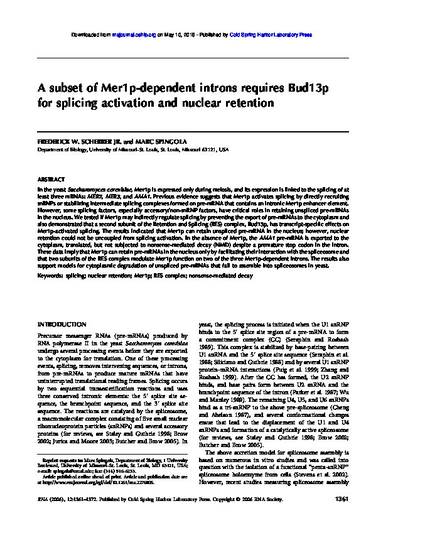
Article
A Subset of Mer1p-Dependent Introns Requires Bud13p for Splicing Activation and Nuclear Retention
RNA
(2006)
Abstract
In the yeast Saccharomyces cerevisiae, Mer1p is expressed only during meiosis, and its expression is linked to the splicing of at least three mRNAs: MER2, MER3, and AMA1. Previous evidence suggests that Mer1p activates splicing by directly recruiting snRNPs or stabilizing intermediate splicing complexes formed on pre-mRNA that contains an intronic Mer1p enhancer element. However, some splicing factors, especially accessory/non-snRNP factors, have critical roles in retaining unspliced pre-mRNAs in the nucleus. We tested if Mer1p may indirectly regulate splicing by preventing the export of pre-mRNAs to the cytoplasm and also demonstrated that a second subunit of the Retention and Splicing (RES) complex, Bud13p, has transcript-specific effects on Mer1p-activated splicing. The results indicated that Mer1p can retain unspliced pre-mRNA in the nucleus; however, nuclear retention could not be uncoupled from splicing activation. In the absence of Mer1p, the AMA1 pre-mRNA is exported to the cytoplasm, translated, but not subjected to nonsense-mediated decay (NMD) despite a premature stop codon in the intron. These data imply that Mer1p can retain pre-mRNAs in the nucleus only by facilitating their interaction with the spliceosome and that two subunits of the RES complex modulate Mer1p function on two of the three Mer1p-dependent introns. The results also support models for cytoplasmic degradation of unspliced pre-mRNAs that fail to assemble into spliceosomes in yeast.
Disciplines
Publication Date
April 13, 2006
DOI
10.1261/rna.2276806
Citation Information
Marc Spingola and Frederick W Scherrer. "A Subset of Mer1p-Dependent Introns Requires Bud13p for Splicing Activation and Nuclear Retention" RNA Vol. 12 (2006) p. 1361 - 1372 Available at: http://works.bepress.com/marc-spingola/13/
